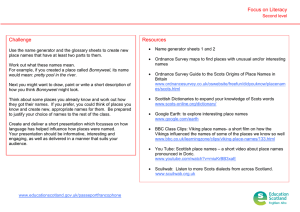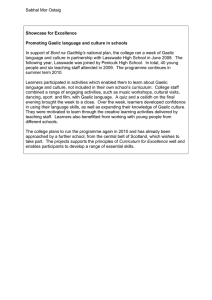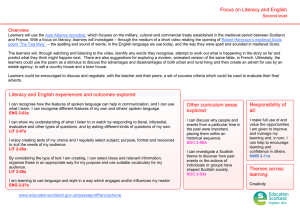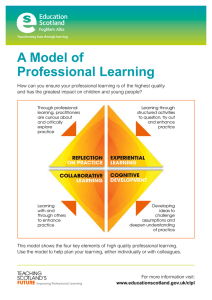Studying Scotland Overview – Third level Scottish Place names
advertisement
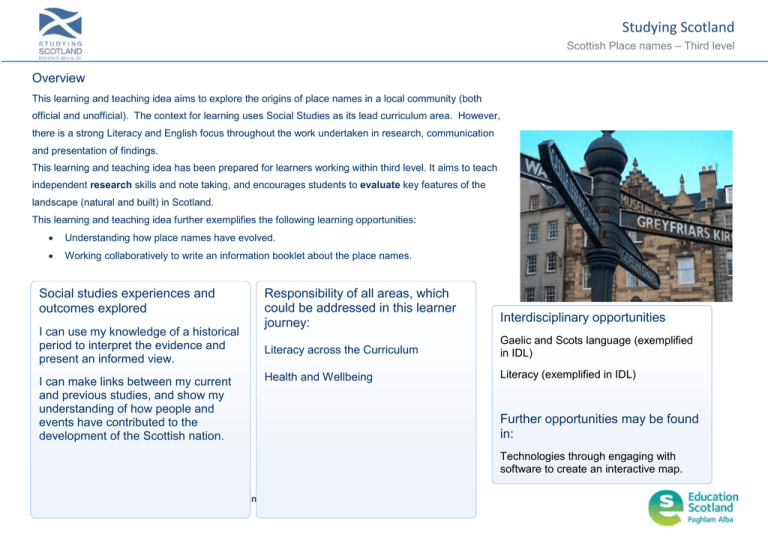
Studying Scotland Scottish Place names – Third level Overview This learning and teaching idea aims to explore the origins of place names in a local community (both official and unofficial). The context for learning uses Social Studies as its lead curriculum area. However, there is a strong Literacy and English focus throughout the work undertaken in research, communication and presentation of findings. This learning and teaching idea has been prepared for learners working within third level. It aims to teach independent research skills and note taking, and encourages students to evaluate key features of the landscape (natural and built) in Scotland. This learning and teaching idea further exemplifies the following learning opportunities: Understanding how place names have evolved. Working collaboratively to write an information booklet about the place names. Social studies experiences and outcomes explored I can use my knowledge of a historical period to interpret the evidence and present an informed view. I can make links between my current and previous studies, and show my understanding of how people and events have contributed to the development of the Scottish nation. Responsibility of all areas, which could be addressed in this learner journey: Interdisciplinary opportunities Literacy across the Curriculum Gaelic and Scots language (exemplified in IDL) Health and Wellbeing Literacy (exemplified in IDL) Further opportunities may be found in: Technologies through engaging with software to create an interactive map. www.educationscotland.gov.uk/studyingscotland 1 Studying Scotland Scottish Place names – Third level Interdisciplinary Learning Interdisciplinary learning is an important element within Curriculum for Excellence. It constitutes one of the four contexts for learning in 'Building the Curriculum 3': o o o o Ethos Life and and ethos life of of the the school school as as aa community community Curriculum areas and subjects Interdisciplinary Learning Opportunities for personal achievement All of these contexts are crucial if the potential of children and young people as successful learners, confident individuals, effective contributors and responsible citizens is to be fully developed. Interdisciplinary learning enables practitioners and learners to: Make connections across learning through exploring clear and relevant links across the curriculum. Support the use and application of what has been taught and learned in new and different ways. Provide opportunities for deeper learning, for example through answering big questions, exploring an issue, solving problems or completing a final project. Focus on curriculum curricular areas areaswhere wherethere thereare arecoherent coherentlinks linksand andan anopportunity opportunitytotodeepen deepenunderstanding. understanding,(Not whilst all building curricularonareas children working and young together people’s or suspension prior of timetables.) learning. A few experiences and outcomes should be carefully selected in relevant curriculum areas. It is important to build children and young people’s next steps in learning into planning, to avoid a ‘one-off project’, which is not connected to prior learning. On the next page, the summary of learning opportunities builds on the overview document and exemplifies a possible interdisciplinary approach, which could be used when This directly the context and the experiences outcomes explored. suggested learning opportunities explore only aspects of the On theplanning. next page, thelinks summary of to learning opportunities builds on theand overview document and These exemplifies possible starting points for an interdisciplinary approach, experiences and outcomes identified. However, each experience and outcome should be revisited in other ways and contexts for depth of learning. which could be used to support planning. This links directly to the context and the experiences and outcomes explored. These suggested learning opportunities explore only aspects of the experiences and outcomes identified. However, each experience and outcome should be revisited in other ways and contexts to ensure depth of learning. www.educationscotland.gov.uk/studyingscotland 2 Studying Scotland Scottish Place names – Third level This interdisciplinary approach shows some possible learning opportunities when the experiences and outcomes listed below are connected. These ideas are starting points and could be used to support planning, depending on your context. In this example we have highlighted a lead curriculum area, however, other curriculum areas can be included where relevant, based on needs and interests. SOCIAL STUDIES Complete a walk from school through village/town to local heritage site or museum/library discussing the names of streets and key buildings. Discuss: the names in relation to the history of the village/town. plaques and marks in the masonry and their significance to the people and industry of the village/town. monuments and their significance to the village/town. local businesses and their historic reference to the village/town. environmental features in the village/town with names from different languages. E.g. Laigh Kirk – Scots Low Church. www.educationscotland.gov.uk/studyingscotland GAELIC LEARNERS ENGLISH AND LITERACY Look at the origins of the place names around your school and identify some from Gaelic and/or Scots. Use reference books/archives at local heritage site to investigate town plans and/or historic maps. Then look at a map of Scotland and find other place names with Gaelic or Scots roots using the ‘Guide to Gaelic Origins of Place Names’ and the ‘Guide to Scots Origins of Place Names’. Relate findings to geographic features on a map. Do the names on Ordnance Survey maps help to tell us the story of what the land looks like? Independently investigate the historical place names found in archives/reference books. (As an extension activity, consider whether they are still used today.) Consider place names from Gaelic and Scots languages and consider implications e.g. Laigh – low compared to high? Or low theologically? Collaboratively write an information booklet about the walk route. Write a report to present findings. RELATED EXPERIENCES AND OUTCOMES: SOC 3-01A, 3-02A, 3-03A, LIT 3-09A, LGL 108A 3 Studying Scotland Scottish Place names – Third level Overview of learning in lead curriculum area Possible prior experiences Learners may have some knowledge of Gaelic and/or Scots. Possible learning opportunities in lead curriculum area Skills for learning, life and work. Independently compare and contrast local area maps from the past and present. Learners may have written or recited in Gaelic and/or Scots. Look at maps, tourist/visitor booklets and local history books. Learners will know and be able to describe their local area. List and discuss the names of places, streets and buildings. Develop an understanding of the evolution and origins of place names. Learners will know the names of areas and streets. Produce a power point presentation about a route. Critically analyse how language relates to locality. Learners may be able to convey information about their local area and places of interest. Produce a booklet about the route. Work both collaboratively and independently to plan and organise a route. Learners may be able to read street and Ordnance Survey maps. Investigate the history and geography of area being visited. www.educationscotland.gov.uk/studyingscotland 4 Possible evidence Say – give a talk to another class, parents or community audience about local place names. Do – make a power point presentation. Write – booklet explaining names encountered on local route. Studying Scotland Scottish Place names – Third level Learning opportunity A: Discuss the history of place names and key features of buildings. Possible Starting Points Resources: Using maps, local history books and the internet, research the place names containing Gaelic or Scots elements. Historic maps (National Library of Scotland): http://maps.nls.uk OS guides to Gaelic and Scots place name elements: http://www.ordnancesurvey.co.uk/oswebsite/docs/ebooks/guideto-scots-origins-of-place-names.pdf Look at the elements which relate to the Gaelic or Scots languages and examine their association with the landscape. Do the place names give us an indication of what the landscape looks like? http://www.ordnancesurvey.co.uk/oswebsite/docs/ebooks/guideto-gaelic-origins-of-place-names.pdf Conduct a guided tour of the local area (a town walk) and inform guests about the place names and their historical origins. Glossary of Scots place name elements: http://swap.nesc.gla.ac.uk/database Local and national library/museum/archives: http://www.nas.gov.uk Learning Learners can Skills: read maps and local history books. Analysing – the impact of language change on place names. communicate effectively, sharing ideas and listening to others. Evaluating – the historical development of place names. speak confidently and knowledgeably to guests on the local walk. Communicating – findings through talk and guided walk. Possible evidence: Research notes, power point presentations, recordings of guided walk. www.educationscotland.gov.uk/studyingscotland 5 Studying Scotland Scottish Place names – Third level Learning Opportunity B: Collaboratively write an information booklet to accompany a guided walk. Possible starting points: Learners will: research monuments, plaques and building markings/crests, local businesses and environmental features of their village/town, and make notes about them. consider what visitors will want to know about, identify areas of interest and decide on the target audiences for their information booklet. Resources for Learning: Local history books Power Point presentation and notes from walk produced for Learning Opportunity A Skills: Organising information into a logical sequence; organise and plan the booklet considering the above factors. Working as part of a team to create a booklet; take photographs and draw diagrams to illustrate points and facts. Analysing and evaluating key information to go into the booklet. write a booklet about the names in the locality surrounding the school. Possible evidence Learning Learners will: Demonstrate knowledge of place names in their local area within an identified route. Analyse and communicate the important historical factors and points of interest along the identified route. Organise information and prioritise information appropriate to the target audience. www.educationscotland.gov.uk/studyingscotland Research notes, annotated photographs and diagrams, information/stories about key people and places and their relevance to the village/town. 6
